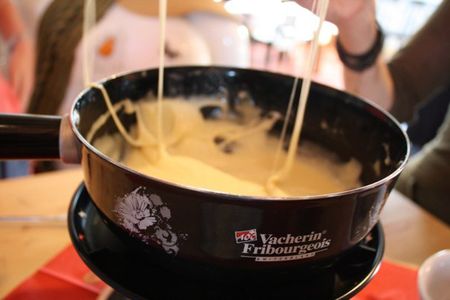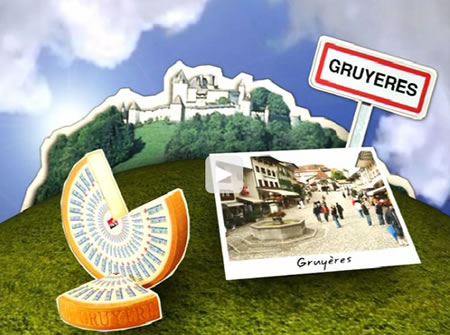Tagged Vacherin Fribourgeois
Moitié-Moitié Fondue
Fondue Moitié-Moitié is well suited for those long winter nights or after a day of skiing while sitting in front of the fire or watching an old movie. With one pot to clean up what could be better? My brother-in-law James has a Swiss friend and colleague who has shared his family recipe for a Fondue Moitié-Moitié using Gruyère and Vacherin Fribourgeois. James makes it on Christmas Day for our family along side of his wife’s Bourbon Glazed Ham.
Fondue refers to several French Swiss communal dishes always shared at the table in an earthenware pot called a “caquelon” or over a small burner called a “réchaud”. The term “fondue” comes from the French “fondre” (“to melt”), referring to the fact that the contents of the pot are kept in a liquid state so that diners can use forks to dip into the sauce. Though cheese fondues are the best known, there are several other possibilities for the contents of the pot and what is used for dipping — recipes are not entirely fixed and vary depending on the cook.
Making fondue is easy – a heavy pot is best, either enamel or cast iron. And as always the better the ingredients the better the result. We were instructed to use Vacherin Fribourgeois & Gruyère and were told it is better to ask for “the “cave-aged” Gruyère as it is only slightly more expensive than the regular one, but it has a much better taste.
Traditional Moitié-Moitié Swiss Fondue
2 cups Dry White Wine (one cup per person)
2 cloves Garlic – finely minced
1 T Cornstarch
1/2 lb Vacherin Fribourgeois & 1/2 lb Gruyère – grated
1 to 2 T Kirschwasser
1 to 2 Baguettes – cubed
Rub the inside of the pot with the two cloves of garlic and place the pot on a medium flame adding 2 cups of the wine and the cornstarch. Blend with a spoon or whisk.
Add the grated cheese and stir consistently until all the cheese has melted and the fondue is smooth. You may want to lower the heat a bit – to keep the cheese from scorching. For safety, remove the pot from the flame and add the Kirschwasser. Stir. Return to the flame and cook to the correct thickness.
The fondue is fully cooked when it is thick enough to coat the back of a wooden spoon – if it is too thick add more wine and continue to stir.
Serve in a fondue pot with cubed bread on skewers – a baguette would be perfect but any good loaf of crust bread would do.
Half the fun of the fondue is in the eating – a glass of dry white wine – preferable chilled is the traditional accompaniment – although a good winter beer is also nice. In a perfect cheese fondue, the fondue mixture is held at a temperature low enough to prevent burning, but hot enough to keep the fondue smooth and liquid. Ideally, when the fondue is finished, there will be a thin crust of toasted (but not burnt) cheese in the bottom of the caquelon. In French, this is commonly referred to as ‘la religieuse’ (“the nun”).
Often a snifter of Kirschwasser is served alongside the fondue – bread dipped in a touch of kirsch just before it is dipped into the fondue pot warms the spirit as well as the heart. And it is important to continue the Swiss tradition of the “dropped” bread. If bread is dropped into the pot – you must kiss someone at the table for good luck. This could be fun but optional depending on the company you keep.
A List of Traditional Swiss Fondues:
Fondue Neuchâteloise: Gruyère and Emmental
Fondue Moitié-Moitié: (half-half): Gruyère and Vacherin Fribourgeois
Fondue Vaudoise: Gruyère
Fondue Fribourgeois: pure Vacherin Fribourgeois (often served with potatoes instead of bread)
Fondue de Suisse centrale: Gruyère, Emmental and Sbrinz
Tomato Fondue: Gruyère, Emmental and crushed tomatoes in the place of wine.
Spicy Fondue: Gruyère, red and green peppers and chilli
Mushroom Fondue: Gruyère, Vacherin Fribourgeois and mushrooms
French Fondues:
Fondue Savoyarde: Comté Savoyard, Beaufort, and Emmental.
Fondue Jurassienne: pure mature and normal Comté
Italian Fondues:
Fonduta: is prepared in the French-minority region of Aosta valley in Italy, and employs Fontina, milk, eggs, and truffles

